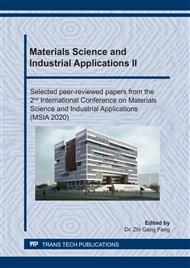[1]
Ghioni M., Gulinatti A., Rech I., Zappa F., Cova S, Progress in Silicon Single-Photon Avalanche Diodes, IEEE Journal of Selected Topics in Quantum Electronics, 2007, 13(4): 852-862.
DOI: 10.1109/jstqe.2007.902088
Google Scholar
[2]
Gudiksen, M. S., Lauhon, L. J., Wang, J., Smith, D. C., Lieber, C. M, Growth of nanowire superlattice structures for nanoscale photonics and electronics, Nature, 2002, 415(6872): 617.
DOI: 10.1038/415617a
Google Scholar
[3]
Jin B, Huang P, Zhang Q, et al, Self-Limited Epitaxial Growth of Ultrathin Nonlayered CdS Flakes for High-Performance Photodetectors, Advanced Functional Materials, 2018, 28(20): 1800181.
DOI: 10.1002/adfm.201800181
Google Scholar
[4]
Mcdonald S.A., Konstantatos G., Zhang S., Cyr P.W., Klem E.J., Levina L., et al, Solution-processed PbS quantum dot infrared photodetectors and photovoltaics , Nature Materials, 2005, 4(2): 138.
DOI: 10.1038/nmat1299
Google Scholar
[5]
Rothman J, Characterization of midwave infrared InSb avalanche photodiode, Journal of Applied Physics, 2015(117): 244502.
DOI: 10.1063/1.4922977
Google Scholar
[6]
D'Costa V R, Tan K H, Jia B W, et al, Mid-infrared to ultraviolet optical properties of InSb grown on GaAs by molecular beam epitaxy, Journal of Applied Physics, 2015, 117(22):2618.
DOI: 10.1063/1.4922586
Google Scholar
[7]
K. Shimoida, H. Tsuchiya, Y. Kamakura, et al, Performance Comparison of InAs, InSb, and GaSb n-Channel Nanowire Metal-Oxide-Semiconductor Field-Effect Transistors in the Ballistic Transport Limit, Applied Physics Express, 2013, 6(3):034301.
DOI: 10.7567/apex.6.034301
Google Scholar
[8]
Singh A, Srivastav V, Pal R, HgCdTe avalanche photodiodes: A review, Opt Laser Technol, 2011, 43(7): 1358–1370.
DOI: 10.1016/j.optlastec.2011.03.009
Google Scholar
[9]
H. Nagata, H. Homma, S. Yamaguchi, Improvement of Electrical and Thermoelectric Properties of MOCVD-Grown InSb Thin Films Using Si-Doped Interfacial Layer, ECS Transactions, 2010, 25(33): 81-86.
DOI: 10.1149/1.3334794
Google Scholar
[10]
D.T.J. Hurle, A thermodynamic analysis of native point defect and dopant solubilities in zinc-blende III-V semiconductors, Journal of Applied Physics, 2010, 107(12):121301.
DOI: 10.1063/1.3386412
Google Scholar
[11]
Liu T S, Peretti E A, The indium-antimony system, Trans. Am. Soc. Met., 1951 ,44:539-548.
Google Scholar


